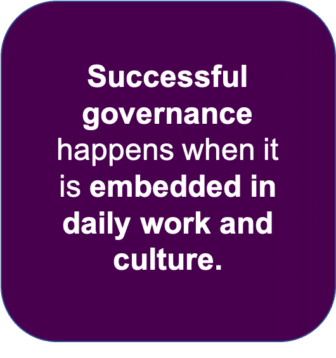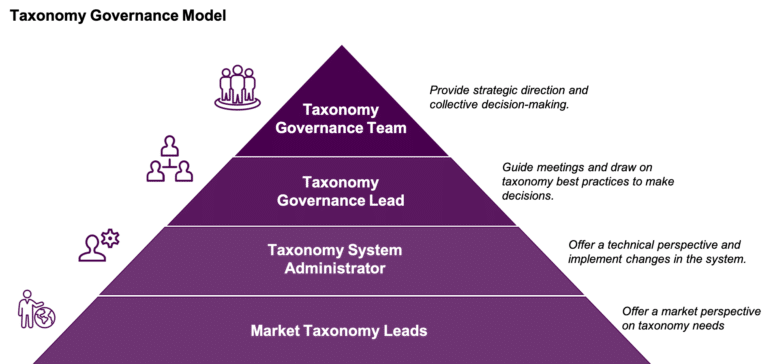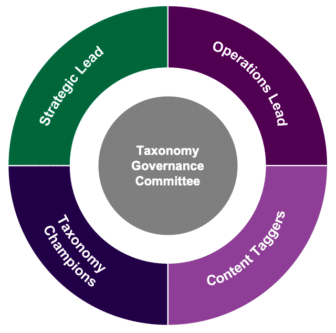Metadata governance is often seen as burdensome, tough to implement, and even harder to prioritize. When organizations embark on a metadata initiative, they tend to focus on design and development rather than governance. Metadata and taxonomies are living tools that evolve with the content they describe. Without a forward-thinking governance plan, the defined metadata will stagnate and fail to offer business value. Organizations that invest in metadata governance benefit from the following:
- Improved business intelligence by linking organizational information to commonly used and accepted terms.
- Procedures and processes that provide more consistent standards for describing and categorizing information and data resulting in consistent branding and customer experience, risk mitigation, etc.
- A strategy to update metadata in accordance with organizational and domain specific needs.
While I’d love to convince you that governance is the most exciting part of a metadata initiative, I’ll settle for convincing you of its importance. The most successful metadata governance consists of three main components: roles and responsibilities; policies & procedures; and metrics to measure growth and change.
In a previous blog, I wrote specifically about the importance of governance when adding new terms to a taxonomy and my go-to approach for determ ining which terms are relevant and where they should live within a taxonomy. In this blog, I wanted to take a step back and share a few best practices for establishing a successful metadata governance plan that accounts for and supports changes to any type of information model. Taxonomy changes might include addition, modification, and deletion of terms while ontology or knowledge graph changes might include changes to an ontology’s entities, relationships, and attributes or changes to the data sources being leveraged.
ining which terms are relevant and where they should live within a taxonomy. In this blog, I wanted to take a step back and share a few best practices for establishing a successful metadata governance plan that accounts for and supports changes to any type of information model. Taxonomy changes might include addition, modification, and deletion of terms while ontology or knowledge graph changes might include changes to an ontology’s entities, relationships, and attributes or changes to the data sources being leveraged.
Most organizations struggle with governance whether they are large or small, hierarchical or flat, remote or in-office, etc. More often than not, a few common mistakes are at the root of unsuccessful governance initiatives. By recognizing and mitigating those mistakes, you can ensure metadata governance that lives, breathes, and grows with your content, data, knowledge, and organization.
1. Just get started.
One of the most common mistakes organizations make is trying too hard to perfect their governance plan instead of getting started. It’s human nature to try and ensure we have the right group of the right participants, the right process diagrams and flows, and a perfectly automated process, but I have seen that those details come with time and iterative review of a working governance process and cannot be accounted for before you start. My advice – just get started. Don’t wait till the stars align, you are much better off getting the first meeting or summit underway and getting the conversation started with the identified individuals. Just as content and metadata will evolve, so will your governance team and your processes. Start from a simple governance model, either hierarchical like the pyramid below, or flatter, represented by a continuous circle, both of which can include a few key roles like a Lead, Business Stakeholders, and and/or a System Admin who can enact changes in a metadata management tool or in an integrated system. A good practice is to implement checkpoints into your governance process or hold retrospectives after the first few meetings or changes. Identify what worked well and where you can improve your governance plan.
 |
 |
2. Keep it simple.
Don’t over-engineer the governance processes to the point where nothing can be completed in a timely or efficient manner. While it is true that organizations vary in governance styles and some may benefit from more centralized governance, keep in mind the time and cost of making decisions and changes to your metadata model. If your governance process requires that every minor change go through two rounds of approval, one at the business level and one at the enterprise level, remember that will increase the time it takes to implement a change both in the central taxonomy management tool and in any consuming systems. The longer a decision making process takes, the more likely your taxonomy will stall, governance processes will be abandoned, or the taxonomy may never reach full adoption. Where possible, limit lengthy decision trees and the need for each suggestion to wait for a quarterly or semi-annual meeting. One way to do this is to outline what a major change is, and what are minor changes, then customizing the approval or change process for each category. This will not only speed the process for minor changes, but will also improve the speed to implementation for major changes by ensuring you have only major changes on each quarterly agenda, resulting in fewer agenda items and less carryover to the next meeting.
3. Dedicate ownership & communicate regularly.
Both the governance process and the metadata itself need to be owned. By owned, we mean having dedicated people to support the ongoing maintenance of the taxonomy and its governance processes. This dedicated ownership does not have to be a full-time role for one individual, it may require only a few hours a month once implemented. Some of the most successful ownership examples came from organizations where the ownership rotated semi-annually and the owner recognized the importance of their role without feeling overburdened.
Using a tool like RACI can be a great option for agile metadata governance teams. RACI stands for Responsible, Accountable, Consulted, and Informed which helps a team to outline who needs to be responsible for the work, who is ultimately accountable, who and when we need to consult, and importantly, who and how we should inform of changes. For example, a major change to a taxonomy (the addition of a new metadata field like Content Type) would require that the Taxonomy Manager be Responsible, perhaps the leader of the taxonomy initiative is Accountable, subject matter experts (SMEs) in content lifecycle and tagging are Consulted, and every consumer of the taxonomy or content may be Informed.
Communicating with end users, consumers, and stakeholders before, during, and after governance meetings is one of the most important ways to keep people engaged in the life and maintenance of a taxonomy, ontology, or other metadata models.
4. Automate where possible.
Leveraging technology to support metadata governance can streamline efforts as metadata initiatives scale and grow. Technology empowers the governance team to rapidly scale processes to new systems while maintaining the integrity of the metadata model. Governance plans that are wired into technology, seamless to the end user, succeed. In other words, the most effective governance doesn’t have to be learned, or followed, it just happens when using the system, because that’s how the system was designed.
Benefits of leveraging technology and automation include the abilities to:
- Manage the metadata in a centralized location versus manually tracking changes via spreadsheets or various databases.
- Enforce access controls on changes to the metadata model and implement workflows to standardize how the model matures.
- Standardize how the various pieces of metadata are consumed by systems to ensure accurate representation and quality enterprise-wide.
A few ways that we’ve seen automation enable and improve the longevity of metadata models and their governance plans are through leveraging system flags to do regular cleanup and archive/remove content or identify metadata that is not being used regularly, the ability to auto-categorize content and enable metadata suggestions based on context, and provision of forms and workflows that allow users to provide suggestions directly to the metadata governance review from within their daily task or system. Mature metadata governance is supported and enabled by technology, reducing manual burden on the governance team.
In Closing
Successful metadata governance saves rework and cost by not re-designing models that have gone stale. If you want help designing a metadata governance plan for your organization that is both customized and follows best practices or implementing a governance framework using the best practices above, contact us.



